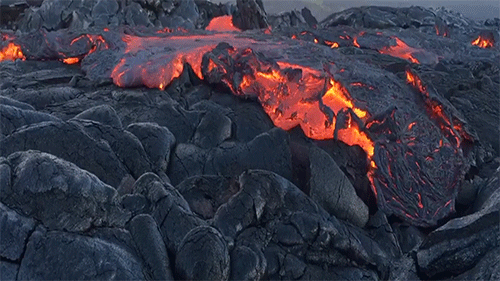A Lava Story
- Edd Villamor
- Nov 26, 2017
- 2 min read

(http://all4desktop.com/4239999-lava.html)
Our Lava Story started below the Earth's crust, when Lava was first a Magma.
What is a Magma?
Magma (from Ancient Greek μάγμα (mágma) meaning "thick unguent") is a mixture of molten or semi-molten rock, volatiles and solids that is found beneath the surface of the Earth.
The type of Lava depends on the type of Magma it originated from.
What are the Different Types of Magma?

1. Basaltic Magma - typically forms when rocks in the upper mantle melt
-Most basaltic magma rises relatively rapidly to Earth’s surface and reacts very little with crustal rocks because of its low viscosity
-It has low viscosity because it has low silica content (about 50%)
-The volcanoes fueled by basaltic magma erupt relatively quietly
2. Andesitic Magma - found along continental margins, where oceanic crust is subducted into Earth’s mantle, and is formed from oceanic crust or oceanic sediments
-contains about 60 percent silica, resulting in an intermediate viscosity
-The volcanoes it fuels are said to have intermediate eruptions
3. Rhyolitic Magma - forms when molten material rises and mixes with the overlying silica- and water-rich continental crust.
-has high viscosity and fuels very explosive volcanoes
How a volcano will be formed and how it will end/die/erode all depends on one very important aspect of its being: its LAVA. In this lesson, we will be talking about the composition and the different types of lava... I hope you "lava" this lesson... <3 <3 <3
TYPES OF LAVA
1. A'a (pronounced as ah-ah)

is a Hawaiian term for lava flows that have a rough rubbly surface composed of broken lava blocks called clinkers
This lava pours out quickly and has a brittle crust
The incredibly spiny surface of a solidified ‘A‘ā flow makes walking very difficult and slow
flows very slowly; has high viscosity
a thick lava flow
A'a is a Hawaiian word which means "stony with rough lava"
2. Pahoehoe Lava (pronounced as pa-hoy-hoy)

Basaltic lava that has a smooth, hummocky, or ropy surface
typically advances as a series of small lobes and toes that continually break out from a cooled crust
flows with low viscosity start to cool when exposed to the low temperature of the atmosphere
Lava with a wrinkled surface that flows slowly
Pahoehoe Lava flow is thinner than A'a
Pahoehoe is a Hawaiian word which means "to paddle". When you paddle in water, swirls are formed on its surface, just like the surface of pahoehoe lava flows
3. Pillow Lava

Mounds of elongate lava pillows formed by repeated oozing and quenching of hot basalt
usually basaltic or andesitic in composition and always associated with water
usually demonstrate a convex upper and concave or flat lower surface. The surfaces are glassy because of very rapid cooling in contact with water

4. Blocky Lava
Cool stiff lava that does not travel far from the erupting vent
Blocky flows are common if the silica content of lavas is higher
They also have highly irregular surfaces covered with debris, but they contain larger lava blocks with smoother sides and angular edges with common dimensions from few decimeters to several meters
Blocky flows grow higher as they advance and may reach more than 100 meters in height
To learn more about the four types of lava, watch this video:
References:
1. http://volcano.oregonstate.edu/book/export/html/131
2. https://www.slideshare.net/lhoralight/science-37094718
3. http://www.soest.hawaii.edu/coasts/lecture/gg101/ powerpoints/Volcanoes.pdf
4. http://all4desktop.com/4239999-lava.html
5. http://volcano.si.edu/learn_galleries.cfm?p=12
6. https://volcanoes.usgs.gov/vsc/glossary/pahoehoe.html
7. https://www.pinterest.co.uk/pin/286823069989528418/?autologin=true
8. https://www.pinterest.com/pin/385480049327588887/?autologin=true
9. http://www.sandatlas.org/types-lava-flows/
10. https://www.youtube.com/watch?v=t6t1guFY9cI












Comments